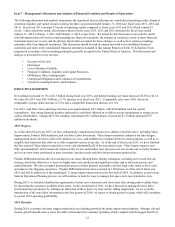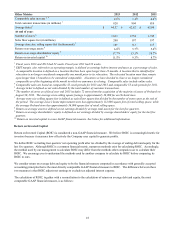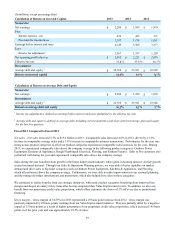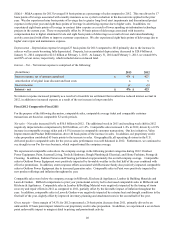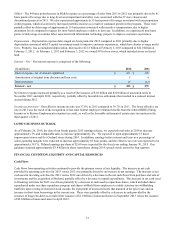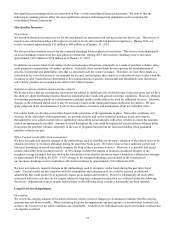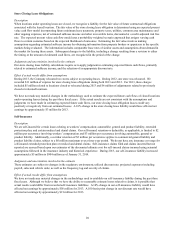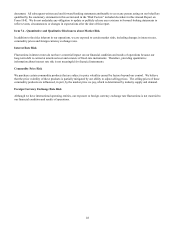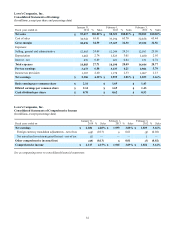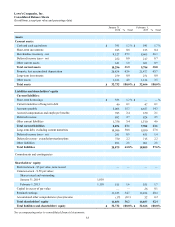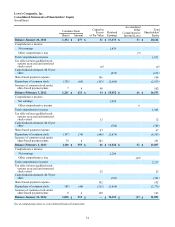Lowe's 2013 Annual Report Download - page 32
Download and view the complete annual report
Please find page 32 of the 2013 Lowe's annual report below. You can navigate through the pages in the report by either clicking on the pages listed below, or by using the keyword search tool below to find specific information within the annual report.24
Our significant accounting policies are described in Note 1 to the consolidated financial statements. We believe that the
following accounting policies affect the most significant estimates and management judgments used in preparing the
consolidated financial statements.
Merchandise Inventory
Description
We record an obsolete inventory reserve for the anticipated loss associated with selling inventories below cost. This reserve is
based on our current knowledge with respect to inventory levels, sales trends and historical experience. During 2013, our
reserve increased approximately $11 million to $68 million as of January 31, 2014.
We also record an inventory reserve for the estimated shrinkage between physical inventories. This reserve is based primarily
on actual shrinkage results from previous physical inventories. During 2013, the inventory shrinkage reserve increased
approximately $16 million to $158 million as of January 31, 2014.
In addition, we receive funds from vendors in the normal course of business, principally as a result of purchase volumes, sales,
early payments or promotions of vendors’ products. Generally, these vendor funds do not represent the reimbursement of
specific, incremental and identifiable costs that we incurred to sell the vendor’s product. Therefore, we treat these funds as a
reduction in the cost of inventory as the amounts are accrued, and recognize these funds as a reduction of cost of sales when the
inventory is sold. Funds that are determined to be reimbursements of specific, incremental and identifiable costs incurred to
sell vendors’ products are recorded as an offset to the related expense.
Judgments and uncertainties involved in the estimate
We do not believe that our merchandise inventories are subject to significant risk of obsolescence in the near term, and we have
the ability to adjust purchasing practices based on anticipated sales trends and general economic conditions. However, changes
in consumer purchasing patterns or a deterioration in product quality could result in the need for additional reserves. Likewise,
changes in the estimated shrink reserve may be necessary, based on the timing and results of physical inventories. We also
apply judgment in the determination of levels of non-productive inventory and assumptions about net realizable value.
For vendor funds, we develop accrual rates based on the provisions of the agreements in place. Due to the complexity and
diversity of the individual vendor agreements, we perform analyses and review historical purchase trends and volumes
throughout the year, adjust accrual rates as appropriate and confirm actual amounts with select vendors to ensure the amounts
earned are appropriately recorded. Amounts accrued throughout the year could be impacted if actual purchase volumes differ
from projected purchase volumes, especially in the case of programs that provide for increased funding when graduated
purchase volumes are met.
Effect if actual results differ from assumptions
We have not made any material changes in the methodology used to establish our inventory valuation or the related reserves for
obsolete inventory or inventory shrinkage during the past three fiscal years. We believe that we have sufficient current and
historical knowledge to record reasonable estimates for both of these inventory reserves. However, it is possible that actual
results could differ from recorded reserves. A 10% change in either the amount of products considered obsolete or the
weighted average estimated loss rate used in the calculation of our obsolete inventory reserve would have affected net earnings
by approximately $4 million for 2013. A 10% change in the estimated shrinkage rate included in the calculation of
our inventory shrinkage reserve would have affected net earnings by approximately $10 million for 2013.
We have not made any material changes in the methodology used to recognize vendor funds during the past three fiscal
years. If actual results are not consistent with the assumptions and estimates used, we could be exposed to additional
adjustments that could positively or negatively impact gross margin and inventory. However, substantially all receivables
associated with these activities do not require subjective long-term estimates because they are collected within the following
fiscal year. Adjustments to gross margin and inventory in the following fiscal year have historically not been material.
Long-Lived Asset Impairment
Description
We review the carrying amounts of locations whenever certain events or changes in circumstances indicate that the carrying
amounts may not be recoverable. When evaluating locations for impairment, our asset group is at an individual location level,
as that is the lowest level for which cash flows are identifiable. Cash flows for individual locations do not include an allocation
of corporate overhead.



